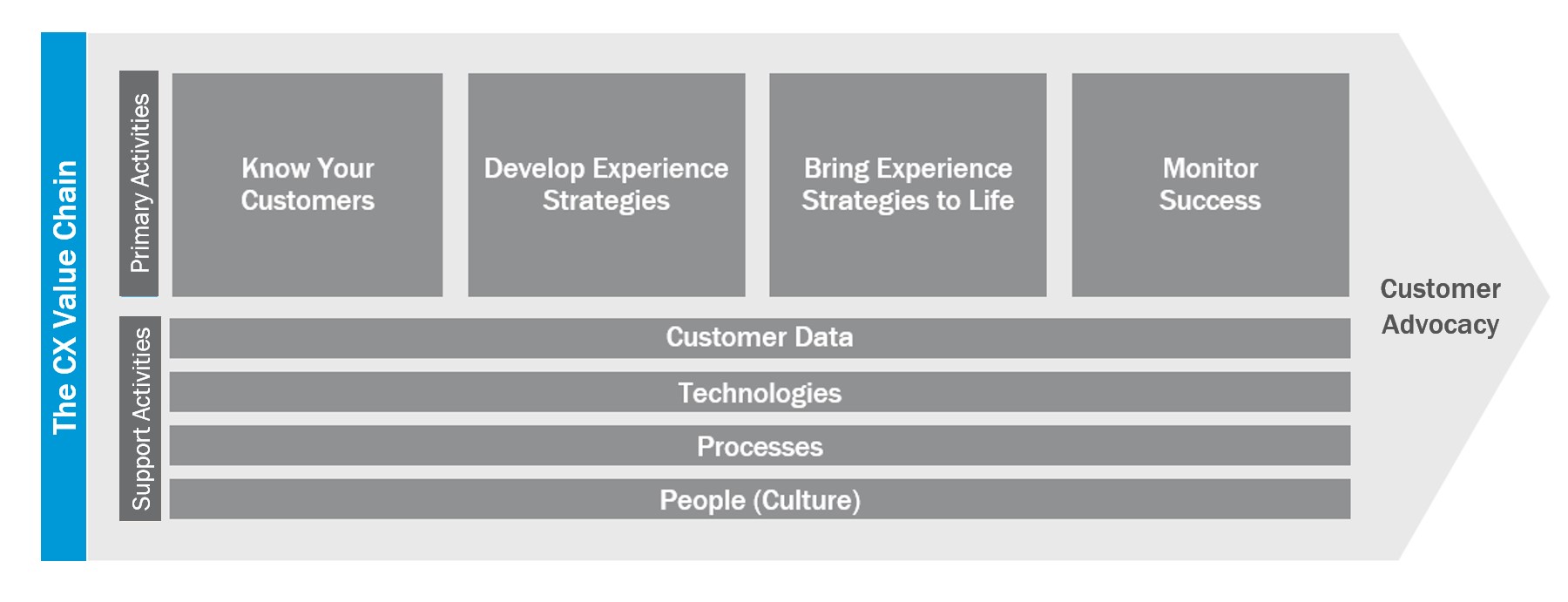
For the last several years, improving customer experience has been rightfully viewed as one of the most important things any organization can do to drive value. In fact, the phrase is used with the same reverence (and lack of clarity) as words like “strategy,” “brand” and “innovation.”
There’s a reason for this that goes well beyond making customers happy. The fact is, customer experience leaders enjoy significantly greater top-line revenue per year than their peers (plus greater profits, faster growth, and better marketing results), by doing a better job managing their customers’ experience.
There is a “secret” these leaders have figured out. They recognize the importance of a consistent, integrated framework for understanding and managing customer experience “all up.” And by following this framework, they consistently drive better results, including greater value for employees, customers and shareholders.
This framework is called the Customer Experience Value Chain.
Making Sense of Customer Experience: The Customer Experience Value Chain
We know that customer experience (CX) means many different things to different people, with myriad definitions, uses, approaches and perspectives. So, how can we make sense of customer experience when *everything* seems to be a part of it?
Simple. By looking at customer experience through the lens of the value it creates, and the activities required to do so.
Much like Michael E. Porter’s Value Chain Framework articulated in his still influential 1985 book, Competitive Advantage: Creating and Sustaining Superior Performance, the Customer Experience Value Chain describes the activities that companies undertake to create value (or ‘margin’) by delivering a better customer experience.
Towards the end of 2016, our firm collaborated with Aberdeen Group to define the Customer Experience Value Chain which was backed by with their best practices research and based on the performance of business leaders who embrace CX. The results are compelling.
Their research shows that Best-in-Class organizations (the top 20 percent) achieve a return on investment and benefits like 35.4% more year-over-year revenue compared to 7.7% for other organizations. They also have 18.2% higher year-over-year profit, while the bottom 80 percent only see 2.9%. You can check it out by downloading their research report, titled, The Customer Experience Value Chain: Paving the Way to Advocacy.
Of course, there is a LOT to learn about customer experience management, and how top companies leverage and optimize the “Customer Experience Value Chain” to realize their out-sized financial and operational benefits.
Step one? Better understand what it is.
A Single Lens to Help Make Sense of and Manage Customer Experience “All Up”
The Customer Experience (CX) Value Chain describes the 8 activities companies should undertake to drive value through customer experience, and the interrelationships and dependencies between them.
The four primary activities, or the “building blocks” of a best-in-class customer experience value chain include:
- Know Your Customers: At heart, this means exactly what it sounds like; really understanding your customers’ wants and needs. CX leaders accomplish this by doing things like establishing a unified view of their customer, true segmentation, deploying Voice-of-the-Customer programs and doing Customer (and Employee, and Member, and Partner…) Journey Mapping.
- Develop Experience Strategies: Defining your CX strategy means having a clear understanding of your CX ”north star,” and making sure it’s aligned to your brand. Leaders also design CX program execution plans and determine metrics for CX success, and clarify stakeholder roles.
- Bring Your Experience Strategies to Life: This is the ability to consistently design and deliver customer-centric experiences. You do this through things like defining and guiding segment-based persona through their ideal journeys, optimizing CX workflow and empowering employees with timely customer insights.
- Monitor Your Success: The best way to scale and systematically improve the experiences you deliver is by understanding how well you’re doing and using this data to improve. Leaders do this through reporting tools and real-time intelligent guidance, analytics to determine strengths and weaknesses, and aligning outside-in and inside-out perspectives.
There are also 4 critical support activities underpinning the CX Value Chain. These are what brings the experience to life—provided they’re guided by the activities noted above. They are of course well known to every business process team and most executives. What’s less well known is the degree to which success the primary activities described above informs and guides the cross-functional organization. They include:
- Customer Data: Through integrated data management, you can connect your audiences, systems and customer information across processes and channels.
- Technologies: By creating a digitally-connected, omnichannel customer experience, you’ll deliver a unified, cross-system, end-to-end experience across segments, journeys, devices and your entire organization.
- Processes: Agile business and CX processes help connect your audiences, systems and customer information across processes and channels.
- People (Culture): By striving for and enabling a customer-centric culture, you’ll empower your people to deliver the experiences your customers need, where they are and when they want.
Customer Experience versus Customer Experience Management.
Where customer experience is how customers feel as a result of doing business with your company, the discipline of Customer Experience Management is the process of systematically designing, delivering and reacting to customer interactions in ways that consistently meet or exceed customer expectations. And best-practice leaders get there by defining and managing an integrated view, using the activities defined in the CX Value Chain.
Nearly every company acknowledges that they need to do customer experience better. In fact, it seems nearly everything a company does to deliver or support any aspect of their business falls under the customer experience banner. Because it does.
Which is why the CX Value Chain covers many—if not most—of the front-and-back of house functions inside organizations. Best practice leading organizations define, understand and embrace this framework for understanding and managing customer experience. By applying the CX Value Chain to your organization, you too can drive significant value for your employees, your customers and your shareholders as a result.